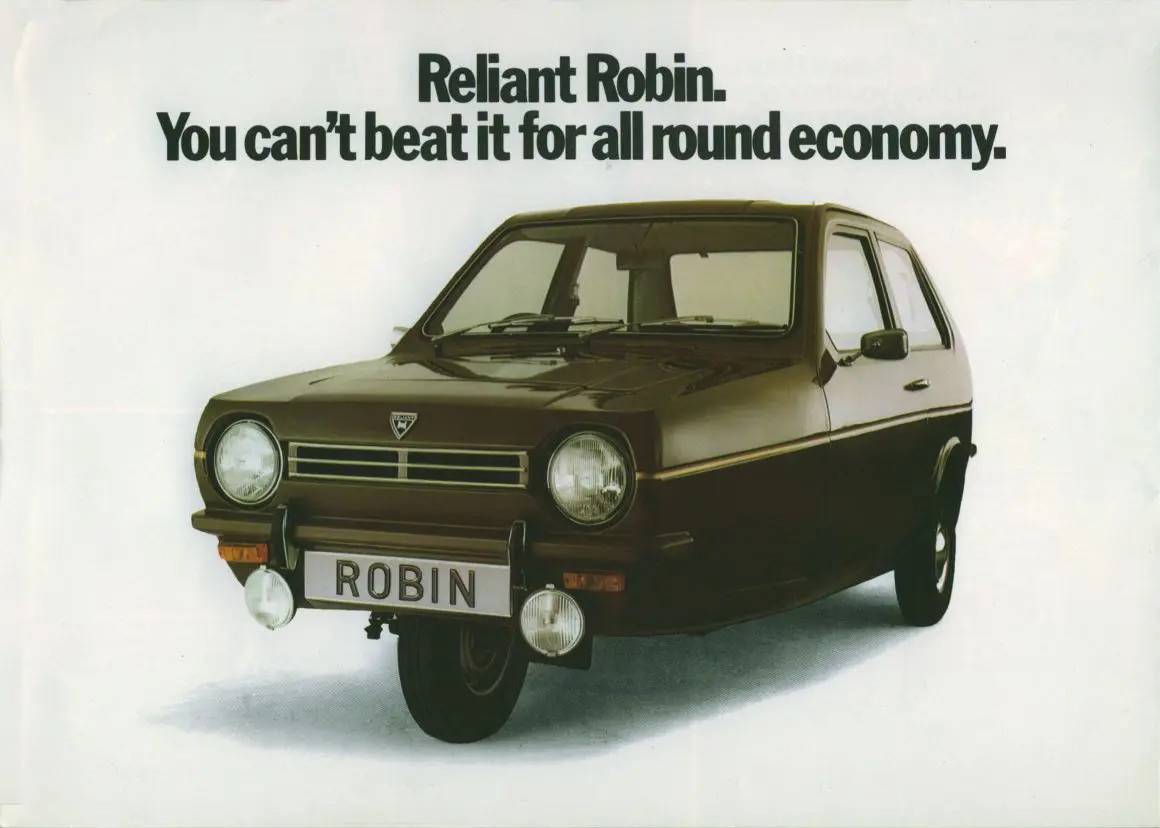THE RELIANT ROBIN AT 50
05 April 2023
Some vehicles are vastly misunderstood, and the Reliant Robin falls into this depressing category. A) On its launch on the 30th of October 1973, it represented a genuinely bold attempt on the part of the Tamworth concern to tempt owners of four-wheel cars to three-wheelers. B) There is no such car as a ‘Robin Reliant’. Finally, C) Only Fools and Horses used a succession of Regal Supervans, not Robins.
Tom Karen of Ogle Design commenced work on a replacement for the Regal 3/25 as early as 1963, the year after its launch. This was to be a new form of three-wheeler, one that would appeal to Mini Clubman and Hillman Imp drivers. If the Regal was considered, slightly unfairly, as perfect transport for whippet racers in flat hats, its replacement was for the ambitious suburbanite. Reliant claimed the new Robin’s interior was more spacious and comfortable than any earlier three-wheeler and that it stood comparison with any economy car.

And by 1973 the Tamworth concern had a virtual monopoly of the British three-wheel marker. The bubble car era had gone the way of Craig Douglas records and winkle-picker shoes, while Reliant had acquired their Bond rivals in 1969. As for the Bug, production was winding down by that time, and it occupied a different sector of the market. The Robin’s goal was not only to appeal to Regal owners but to convince car drivers of the joys of three wheel motoring.
Your friendly local Reliant dealer would tell you the 750cc aluminium engine OHV engine was capable of 73 mph and how the Robin was the first three-wheeler with an anti-roll bar. The smartly innocuous bodywork included a hatchback rear window – a feature lacking on the Mini – and with the rear seat folded, the luggage capacity was 30 cubic feet. The basic version cost £801.39 and road tax of just £10 per annum (compared with £25 for a four-wheel car) was another advantage of Reliant ownership.
For the status seeker, there was the £848.46 ‘Super Robin’ with fog and spot lamps, hazard warning lights, a passenger sun visor with a vanity mirror, and additional instruments. There was even a “chromium-plated lockable petrol cap” to cause a stir in Acacia Avenue and the Super Robin accounted for 60% of early sales.
One advertisement proclaimed “10% Deposit 4 YEARS TO PAY Road Tax only £l0 per year Up to 63 mph”. Another dealer boasted “PETROL RATIONING No Problem WITH THE SPARKLING NEW RELIANT ROBIN - A NEW CONCEPTION IN 3 WHEELER MOTORING.” In the aftermath of the OPEC Fuel Crisis, the government contemplated reintroducing petrol coupons.
But the Reliant offered more than economical motoring; the brochure promised “the sporty wheel and the column controls put you in total command.” The management at Tamworth hoped the Robin would appeal to female drivers. To quote one newspaper “Reliant believe that women of all ages will take bird's eye view” of the Robin and will conclude that its estate car capacity, ease of handling and parking make it a perfect vehicle for them.” 1973 was a long time ago.
The Robin proved so successful that four months after its launch, dealers reported sales were already passing the 6,000 mark. Owners included HRH Princess Anne and Roy Orbison when Tony Bastable evaluated an early example for Thames Television’s Drive In, he praised the GRP bodywork, and economy. He also noted that former motorcyclists now represented a “dwindling” proportion of Reliant’s customer base.
However, Bastable believed “in certain situations, from emergency avoidances to sudden cross winds, three wheels stand too good a chance of being less stable than four” - (126) Reliant Robin | Three Wheeler | British Cars | Drive in | 1973 - YouTube. This remains a controversial issue among many owners and is one we will address in a special owner’s profile. For now, here is some priceless footage of the Reliant works in 1975 - ATV Today: 06.06.1975: Margaret Thatcher visiting Reliant car factory | MACE Archive
PS There really is no such car as the ‘Robin Reliant’…
